
By no means do I consider myself a good photographer; I have never taken a class on the subject, nor am I able to mentally justify expensive equipment. I will normally only find two or three decent photos on every roll of exposed film. Nevertheless, I have always been an eager photographer, and this fact is what made Avocado Memories possible! Once, I stopped by a Creative Memories open house/workshop. (CM are the folks who market archival quality scrapbooks and accessories. They were among the very first, I think, and started the boom in scrapbooking.) As I arrived, the hostess met me at the door and said, "You must be Wes Clark," knowing my name from her mailing list. "How did you know?" I asked. "We don't get many men doing this sort of thing," she replied. She also gave it as her opinion that the men who do scrapbooking are usually writers, historians and photographers. I fit into all three categories. Add some interest in computer networking and HTML, and you can see Avocado Memories is just a sort of electronic scrapbook.
Mom used to accuse Dad with, "A poor craftsman always blames his tools!" So let's look at some of my photographic tools. The photos below come from e-Bay, an invaluable research tool in addition to being the world's biggest auction.
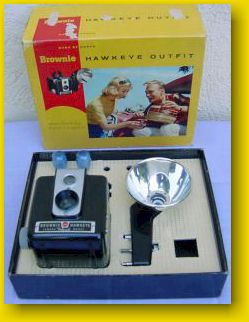
The first camera I can recall our having is the Kodak Brownie Hawkeye, shown above. All of the photos on Avocado Memories taken prior to about 1965 were taken with this camera. In retrospect, I see that the images are much better with this camera than with the Instamatic camera we started using later! (And the colors on the prints have been more stable.) It took 620 roll film, which I thought came in cool-looking little boxes and had a case that felt like bakelite. I thought it was hopelessly old-fashioned, but used it occasionally just for fun. The curious thing about it was the viewfinder: to frame the shot you didn't hold it up to your face, but rather held it at the mid-chest line and looked down at an image in a glass. The flash bolted onto the side and took enormous blue bulbs with a sort of small Brillo pad within. The earliest photos taken with this camera show me as an infant, so I suppose this camera was bought around when I was born, in 1956. Click here to see how much you'd pay for one of these in 1955.
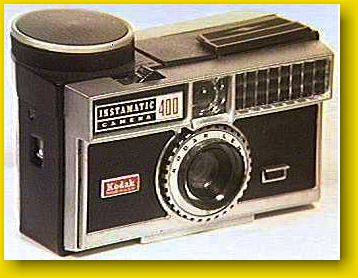
Mom brought this Instamatic 400 camera home from work in 1965 or so. I think I recall her saying she stole it! Anyway, I liked it because it had a spring-wound automatic advance mechanism; it also looked futuristic. I also liked the way the flash was integrated into the body. Pushing a button on the face would pop up the little chamber for the flash bulb. It took 126 format film cartridges, so it was simple to load. The only problem, in retrospect, is that it took crappy photos! And unfortunately, the great majority of the photos on Avocado Memories were taken with this Instamatic. I quit using it when I bought my first 35 mm SLR - a Petri FT EE. No, I didn't keep any of the negatives; these were thrown out.
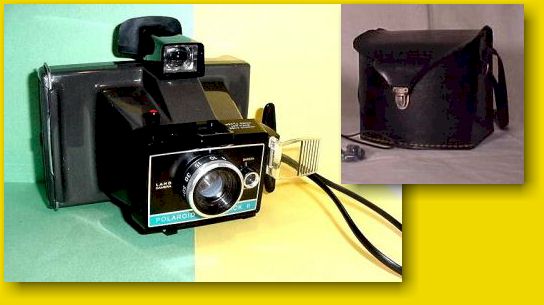
When our friend Mary and her daughter Angela moved to an apartment on Victory Boulevard in 1971, I did some scouting around in a nearby empty apartment. Lo and behold, there was a Polaroid Colorpack II in the closet, which I helped myself to. The camera was in a big, clunky case - shown above. Ours had a gray plastic body; the one in the picture appears to be black. The flashcube was a real advance over the Kodak Instamatic's bulbs. (Note for young folks: a flashcube contained four bulbs in a clear plastic square. A mechanism rotated the cube ninety degrees with each exposure.) I used this camera from 1971 to about 1976.
I have long since given up theft as entertainment.
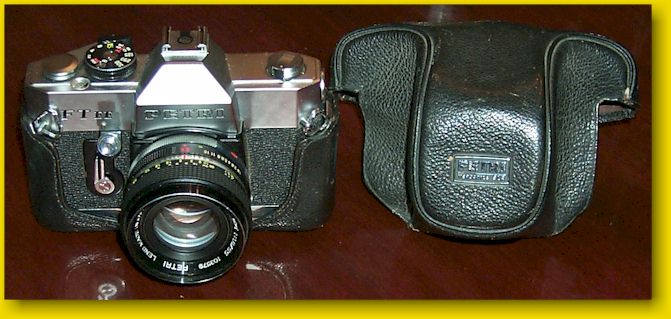
In 1976 I traded the Sanyo quadraphonic 8 track player I had in my VW Beetle for my first 35mm SLR camera from a fellow Marine; it was a 1968 vintage Petri FT EE. 35mm photography was a major revelation to me. The images were so much better than with the cameras above. Better yet, I used the Camp Pendleton photo lab to develop my film and make my own black and white prints. I still have the Petri. Once, I took it on the "Montazooma's Revenge" roller-coaster at Knott's Berry Farm and ruined the lens. That was in 1979; I didn't get a replacement lens for it (from e-Bay) until 1999. During that time I used a Pentax K-1000. The Pentax is in good working condition - in fact, my son used it for a photography class in college and my daughter uses it for a high school photography class. I note it is still worth approximately what I paid for it more than twenty years ago!
Nowadays I use a Nikon D100 6.1 megapixel digital SLR and Photoshop 7.0 for exposure and color corrections - a far, far cry from the Kodak Instamatic!
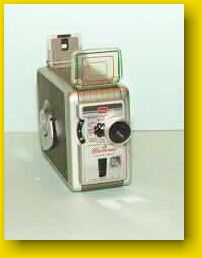
Our 8 mm home movies were shot on 8 mm with a Brownie camera like this. That dual flip-up viewfinder system always threw Mom off: all of our family films have close-ups of kids centered on their mouths, with the tops of their heads out of the frame. The other thing Mom never came to terms with was the fact that the camera had to be wound frequently; many of the family films are oddly sped up because the camera was under-cranked (a movie industry term - you see the effect a lot with old Little Rascals films). Click here to see how much you'd pay for the Brownie movie outfit in 1955.
In 1977 I bought a Bell and Howell Super 8 mm camera. While in the Marine Corps I used it to take some dull action images of guys working on telephone lines. In 1986 Mom bought my wife and I a VHS-based VCR; my children have a good deal of their lives documented in a far more complete fashion than I ever did!